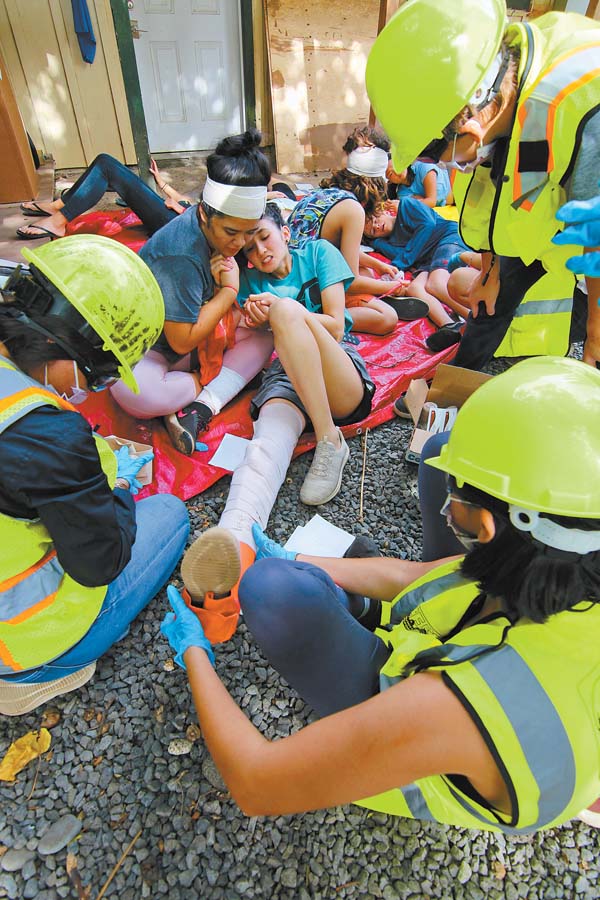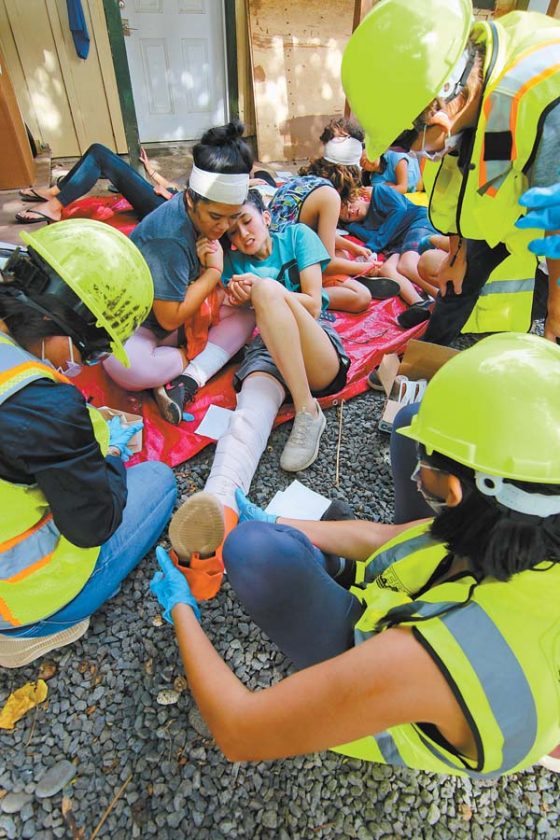
Kayli Amuro (center, left) consoles Caelia Pierner as her leg is placed on a splint and bandaged during a simulated disaster exercise at Camp Olowalu on Sunday morning. The simulation was part of the final test for the latest crop of graduates in the Maui Hero Project, a program that teaches disaster preparedness to youth. The Maui News / COLLEEN UECHI photos
OLOWALU — Ear-piercing screams are ringing from the seaside cabins at Camp Olowalu.
Lying in each of the cabins are kids in various states of injury and pain — a neck laceration (made of Halloween store blood and molding clay), a protruding bone fracture (a stick taped to a leg) and a missing limb (tucked carefully inside the victim’s T-shirt).
Hurrying towards the cabins are an unlikely team of rescuers — King Kekaulike High School 9th-graders, equipped with hard hats and reflective vests. They evaluate the safety of the cabins on clipboards and mark each of the victims with colored ribbons so they can be transported safely to the triage station.
“Put pressure on it,” rescuer Arlee Millivon calmly instructs a boy with blood dripping down his arm.
The students know the carnage isn’t real, but they treat it like it is, hoping that one day, they’ll be prepared for the real thing. The exercise at Camp Olowalu on Sunday morning was the final simulation for the latest group of graduates in the Maui Hero Project, a program that equips youth to respond in disasters. Some hope to use the skills as first responders; others just want to help their families and communities in times of need.
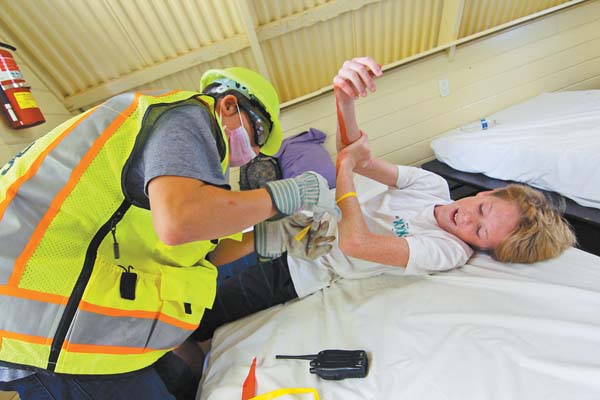
Arlee Millivon marks Nicholas McCartin with a yellow ribbon to indicate that he needs medical attention but can wait while first responders tend to more life-threatening injuries.
“It never ceases to amaze me how much these kids care about each other and the community they’re a part of,” said program instructor Loren Lapow. “I think the spark of enthusiasm and curiosity is strong, and that they’ll really reflect on this experience and find strength and hope in the way they all acted as a team.”
Seven students are in the latest crop of graduates. Overall, the weekend excursion at Camp Olowalu drew 24 kids — including past graduates — from Kalama Intermediate, King Kekaulike High School, Baldwin High School and Hawaii Technology Academy. Sunday’s simulation was the aftermath of a tsunami, but the students could find themselves in all manner of situations.
“We actually hope that they never have to be in a disaster. However, the skills are still relevant in everyday life,” said Nancy Ooki, extension agent for the Youth Development Program at the University of Hawaii at Manoa. “They could have to put out a fire in their home. They could have a relative have a heart attack and have to do CPR. They could have to do first aid.
“But to me, honestly, I think the bigger skill they come away with is they’re the person that’s going to step up when something happens. They’re going to be calm. They’re going to be a little more confident in taking the leadership role while others around them might not be.”
Ooki and Lapow are partners in teen disaster preparedness training. Lapow runs the Maui Hero Project; Ooki is with My Preparedness Initiative (MyPI) Hawaii, a program that’s part of a national initiative to prepare and educate youth. Ooki adapted the program for Hawaii in 2017. It recently completed its pilot run, and Ooki is seeking out new grants as well as volunteer adult instructors.
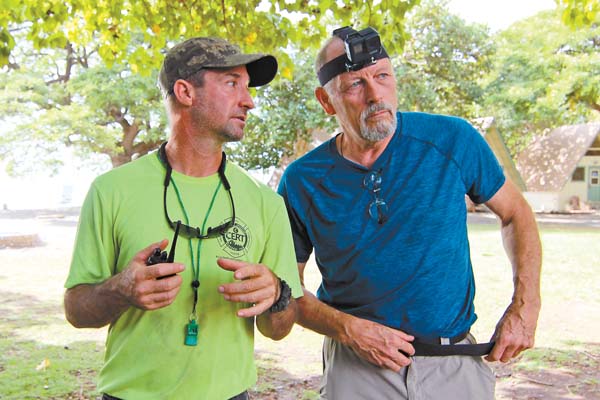
Program instructor Loren Lapow consults with David Bruce Leonard during the simulation Sunday. Leonard, an herbalist and acupuncturist, volunteered to teach the kids la‘au lapa‘au, traditional Native Hawaiian medicinal techniques.
The Maui Hero Project operated as a program of Aloha House from 2000 to 2010 with the help of a federal grant, Lapow said. It ran as The Hero Project on the Mainland before restarting on Maui in 2018. The program is in the second year of a $400,000, five-year grant from the state Office of Youth Services.
Students in the program undertake 100 hours of training that follows the national Community Emergency Response Team curriculum — disaster preparedness, triage, first aid, fire safety and suppression, disaster psychology and even terrorism.
“Sometimes I tell them, the disaster you may be most likely to experience will be an active shooter at school,” Lapow said.
Per their training, the students aren’t supposed to respond to terrorism events like school shootings. However, Ooki and Lapow pointed out that they would have the skills to administer first aid, keep classmates calm and help deal with the trauma that follows.
“Yes, you can ‘run, hide, fight,’ but more so than that, after the fact or even during, how can you help your fellow students stay calm, be present?” Lapow said. “And after, how can you support each other and deal with the loss? Whether it’s a suicide or a shooting or a loss that affects everybody, like the loss of a principal or teacher.”
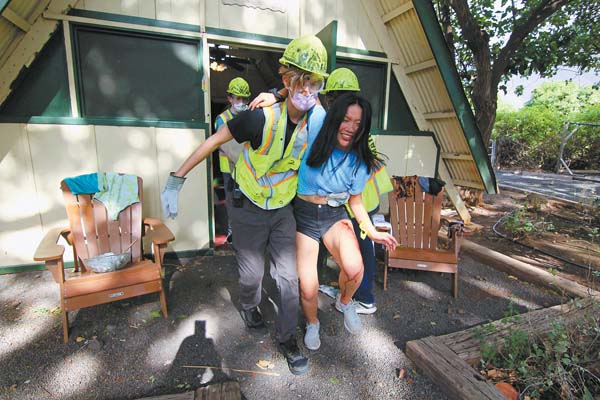
Lyric Hammond-Toole (left) helps Naomi Farnsworth out of a cabin during the disaster simulation Sunday.
Everyone’s been a victim of something — the loss of a loved one, an accident, an illness, said Lapow, who holds a master’s in social work. Those experiences can turn people into “villains,” pushing them toward dangerous life decisions, but Lapow hopes the students will use their trials to learn, grow and become the heroes of their own stories.
Lapow is also passionate about including cultural aspects, pointing to Native Hawaiians as a picture of resiliency for the way they battled everything from natural disasters to the arrival of Western diseases. On Sunday, renowned local musician Brother Noland came to talk to the kids about kapu aloha, and they also got a crash course in the traditional Hawaiian medicinal arts of la’au lapa’au.
Brandon Clark, a 9th-grader at King Kekaulike High School and one of the students in the most recent class, was worn out after a morning of carrying his “wounded” classmates and even rescuing a mannequin from the ocean.
“It was chaotic walking into the last room, because everyone was screaming and I couldn’t hear anything,” he said.
Clark said he doesn’t like blood or loud noises but that he overcame the challenges by remembering his fundamentals and “sucking it up and breathing as much as I could.”
“It’s training me for a disaster situation, and it builds endurance, I could say, for this kind of thing,” said Clark, who envisions a career in the military someday. “Once you get it down a couple of times, then you memorize it. It’s also good for practice, especially because I’m so squeamish.”
Victoria Gil Coca, a sophomore at Kekaulike who applied the realistic wound makeup to her classmates, said she’s learned not only outdoor survival and first aid skills, but also how to “be at peace with yourself.” On Saturday the group sat in a circle and shared some of their personal hardships.
“Taking care of other people, it’s a lot to face mentally,” said Gil Coca, pointing out that you have to be the one to tell people, ” ‘Don’t freak out. Don’t freak out.’ It takes a lot of confidence to have that kind of connection with yourself to be like, ‘OK, I’m putting them before myself.’ “
Kekaulike sophomore Caelia Pierner said Lapow visited their 9th-grade class and told them what an amazing experience the program would be and how it would look good on a college resume.
“I kind of joined for the college resume, but then I kind of fell in love with everything,” she said. “You learn so many different things — how to triage people, how to do CPR, somewhat of lifeguarding. It’s just a really amazing experience, and you can actually provide help to the community.”
* Colleen Uechi can be reached at [email protected].
- WEST PALM BEACH, FL – FEBRUARY 22: Kurt Suzuki #28 of the Washington Nationals poses during Photo Day on Friday, February 22, 2019 at the FITTEAM Ballpark of the Palm Beaches in West Palm Beach, Florida. (Photo by Mary DeCicco/MLB Photos via Getty Images) *** Local Caption *** Kurt Suzuki
- Kayli Amuro (center, left) consoles Caelia Pierner as her leg is placed on a splint and bandaged during a simulated disaster exercise at Camp Olowalu on Sunday morning. The simulation was part of the final test for the latest crop of graduates in the Maui Hero Project, a program that teaches disaster preparedness to youth. The Maui News / COLLEEN UECHI photos
- Arlee Millivon marks Nicholas McCartin with a yellow ribbon to indicate that he needs medical attention but can wait while first responders tend to more life-threatening injuries.
- Lyric Hammond-Toole (left) helps Naomi Farnsworth out of a cabin during the disaster simulation Sunday.
- Program instructor Loren Lapow consults with David Bruce Leonard during the simulation Sunday. Leonard, an herbalist and acupuncturist, volunteered to teach the kids la‘au lapa‘au, traditional Native Hawaiian medicinal techniques.
- A brush fire that charred nearly 600 acres came within inches of Doris Todd Christian Academy’s sports field in Paia where crews were mopping up Sunday morning.
- Maui Fire Department firefighters were on campus at Doris Todd Christian Academy in Paia on Sunday morning to extinguish hot spots. The fire was 100 percent contained as of Sunday morning. The Maui News / KEHAULANI CERIZO photos


